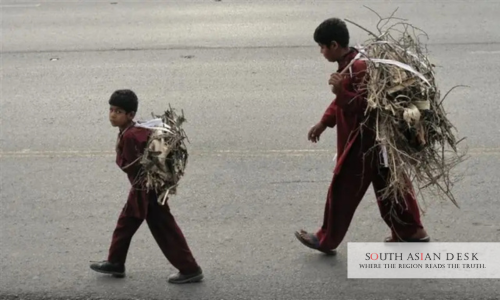Karachi, August 25, 2025 – The Sindh child labour survey released on Monday reveals that 1.3 million children aged 5-17 face child labour in Sindh, with agriculture claiming 65 per cent of victims. Officials from the Labour Department and UNICEF presented their findings at a launch in Karachi. This data, drawn from 61,859 households across 29 districts, underscores the hazardous child work Sindh endures, affecting education and health for generations.
Child Labour Undermines South Asian Progress
1.3 million children in Sindh represent a stark barrier to South Asia’s development goals. Pakistan’s child workforce fuels informal economies but perpetuates cycles of poverty that spill into India and Bangladesh via migration and trade. With a 10.3 percent prevalence, Sindh mirrors regional trends, where 138 million children toil globally, according to ILO estimates. Disruptions from climate shocks, such as the 2022 floods, amplify risks, increasing child labour by 10 percent in affected areas. This crisis strains remittances, worth $30 billion annually to Pakistan, and burdens education systems already serving 22 million out-of-school children across the subcontinent. Eradicating it demands cross-border collaboration to safeguard futures amid rising inequality.
Sindh Child Labour Survey Unveils Alarming Scale
The Sindh Child Labour Survey, conducted from 2023 to 2024, marks the first comprehensive investigation in nearly three decades. It sampled 56,967 households, achieving a response rate of 92%. Researchers interviewed 119,965 children aged 5-17, yielding a response rate of 93.6% among children.
Prevalence stands at 10.3 per cent overall, down from 20.6 per cent in 1996. Boys suffer from 13.7 percent rates, while girls suffer from 6.6 percent rates. Age groups show an escalation: 4.3 percent for 5-9 year-olds, 13.2 percent for 10-13 year-olds, and 18.5 percent for 14-17 year-olds.
District disparities hit hard. Sujawal records 35.1 per cent, Tharparkar 25.6 per cent. Urban Malir logs just 2.7 percent, while Karachi South logs 3 percent. Rural areas bear 54 percent of the child population but host the majority of labourers.
Economic drivers dominate. Poorest households see 33.7 per cent involvement, richest 3.8 per cent. Forty-four per cent of cases stem from income supplementation. The Benazir Income Support Programme aids 47.1 percent of affected homes, yet gaps persist.
“Every child deserves a childhood filled with learning, play, and opportunity—not labour,” UNICEF Child Protection Chief Jennifer Melton stated at the launch. The survey aligns with SIMPOC methodology, adding mental health insights for the first time.
Hazardous Child Work in Sindh Imperils Young Lives
Hazardous child work in Sindh affects 50.4 per cent of 10-17-year-olds in labour. Over 75 per cent log more than 42 hours weekly. Twenty-nine per cent haul heavy loads, 28 per cent face extreme temperatures, and 17.5 per cent endure abuse.
Agriculture tops the list of hazards, with 55.1 percent of laborers working in fields, forests, or fisheries. Child labor in agriculture in Pakistan extends this pattern nationally, with 12 million children working, according to federal data. In Sindh, 18.7 percent serve as skilled agricultural workers, while 54.9 percent hold elementary roles.
Injuries plague 43.5 per cent of labourers, versus 20.6 per cent of non-workers. Depression symptoms afflict 20.1 per cent, mild to severe. Abuse hits 17.5 per cent: psychological is the most common, then physical, and sexual is the least, but is rising away from home.
Work sites are split 78.3 percent off-site, 21.7 percent domestic. Unpaid family roles claim 49.6 per cent. Night shifts account for 20.5 percent, and tool hazards account for 2.2 percent.
Labour Secretary Asadullah Abro pledged stricter enforcement of the Sindh Prohibition of Employment of Children Act, 2017. “We must protect education and childhood,” he said. The Act bans the employment of under-14s and sets 18 as the hazardous minimum age.
Child Labour Agriculture Pakistan Dominates Sindh Fields
Child labour in agriculture in Pakistan thrives in Sindh’s vast farmlands, ensnaring 65 per cent of the 1.3 million children in child labour in Sindh. Survey data show 8.1 percent as agricultural labourers and 8.2 percent as self-employed farmers.
Floods from 2022 doubled the rates in hit zones: 22.3 percent were severely affected versus 12.1 percent untouched. Price inflation spikes involvement most, followed by crop failures.
Median work hours reach 30 weekly for non-schoolers, 18 for attendees. Fatigue reports 43.5 per cent. Long treks to fields cut leisure time.
Nationally, agriculture accounts for 70 percent of child workers, according to the Pakistan Bureau of Statistics. Sindh’s 15.6 million child population amplifies the issue, with a rural share of 54 percent.
Director General of Labour Zulfikar Ali Nizamani emphasized the importance of awareness drives. “Enforcement and collaboration will end this,” he noted. UNICEF supports policy shifts, as indicated in its 2024 annual report.
Education suffers acutely. Only 41.2 per cent of labourers attend school, compared to 69.9 per cent of non-workers, among 14-17 year-olds; 29.1 per cent persist. Non-attendance cites fees (32.3 per cent) and work duties.
Girls fare worse in chores, 56.6 per cent engaged, often housebound. Boys shop more. Disabilities affect 1.6 per cent of children; they are more likely to face barriers.
Background: Decades of Neglect Fuel Exploitation
Sindh’s roots in child labour date back to the feudal agrarian systems that emerged after Partition. Federal surveys in 1996 and 2010 flagged declines, but gaps lingered. The 2017 Act targeted bans, yet inspections lag.
UNICEF aided the survey, committing to systems building. Global ILO conventions bind Pakistan, yet enforcement falters amid 40 per cent poverty.
Migration adds layers: a 10.6 percent prevalence in mover-headed homes. Female-led households hit 4.9 per cent.
What’s Next: Policy Pivot to Protection
Authorities eye inter-sectoral plans by year-end. BISP expansions and school stipends, disbursing PKR 2.4 billion to 1.3 million families, offer levers for improvement. Flood-resilient farming could curb shocks.
1.3 million children in Sindh demand swift action against child labour. Eradication hinges on turning survey insights into enforceable safeguards, restoring childhoods lost to fields and factories.
Published in SouthAsianDesk, October 25th, 2025
Follow SouthAsianDesk on X, Instagram, and Facebook for insights on business and current affairs from across South Asia.






